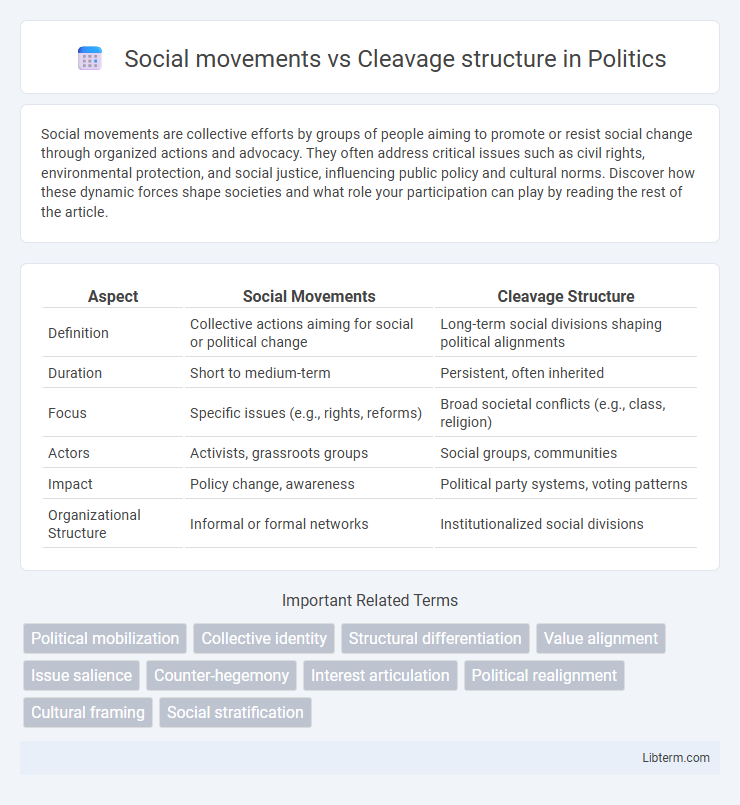Social movements are collective efforts by groups of people aiming to promote or resist social change through organized actions and advocacy. They often address critical issues such as civil rights, environmental protection, and social justice, influencing public policy and cultural norms. Discover how these dynamic forces shape societies and what role your participation can play by reading the rest of the article.
Table of Comparison
| Aspect | Social Movements | Cleavage Structure |
|---|---|---|
| Definition | Collective actions aiming for social or political change | Long-term social divisions shaping political alignments |
| Duration | Short to medium-term | Persistent, often inherited |
| Focus | Specific issues (e.g., rights, reforms) | Broad societal conflicts (e.g., class, religion) |
| Actors | Activists, grassroots groups | Social groups, communities |
| Impact | Policy change, awareness | Political party systems, voting patterns |
| Organizational Structure | Informal or formal networks | Institutionalized social divisions |
Understanding Social Movements: Definition and Characteristics
Social movements are collective efforts by groups aiming to enact, resist, or undo social change, distinguished by organized, sustained activities and shared goals. Unlike cleavage structures, which are long-term divisions in society based on factors like class, religion, or ethnicity, social movements arise dynamically in response to perceived injustices and mobilize resources to influence public policy or cultural norms. Key characteristics include collective identity, contentious politics, and the deployment of framing strategies that resonate with broader societal values.
Cleavage Structure: Concept and Historical Context
Cleavage structure refers to enduring social divisions, such as class, religion, and ethnicity, that shape political alignments and party systems. Originating from Lipset and Rokkan's theory, cleavage structures historically emerged from key societal conflicts during nation-building processes in Europe, including center-periphery tensions and church-state divisions. These deep-rooted cleavages influence voter behavior and form the basis for sustained political competition across generations.
Origins and Development of Social Movements
Social movements often emerge from existing cleavage structures defined by social divisions such as class, ethnicity, or religion that create collective identities and grievances. These movements develop as organized efforts seeking social change by mobilizing discontent rooted in the socioeconomic or political inequalities embedded within cleavage systems. The interplay between cleavage structures and social movements highlights how longstanding social divisions serve both as catalysts and frameworks for collective action and identity formation.
Types of Social Cleavages in Society
Social cleavages refer to deep and lasting divisions within society, often based on factors such as ethnicity, religion, social class, and language, which form the foundations of political and social conflicts. These social cleavages typically include ethnic cleavages, religious cleavages, class-based cleavages, and linguistic cleavages, each influencing group identities and political alignments. Social movements arise in response to these cleavages, mobilizing collective action to challenge, reinforce, or transform existing social structures and power relations.
Interplay Between Social Movements and Cleavage Structures
Social movements challenge and reshape existing cleavage structures by mobilizing collective identities around issues such as class, ethnicity, or religion, leading to shifts in political alignments and social norms. These movements often arise from perceived inequalities embedded within cleavage systems, transforming latent conflicts into organized demands for change. The dynamic interplay between social movements and cleavage structures drives societal evolution by continuously redefining group boundaries and political agendas.
Social Movements as Agents of Cleavage Transformation
Social movements act as dynamic agents of cleavage transformation by challenging established social divisions and mobilizing marginalized groups around shared grievances and identities. These movements reconfigure political alliances, reshape collective identities, and drive changes in policy agendas, thereby altering the traditional cleavage structures embedded in society. Through sustained activism and grassroots organization, social movements catalyze the emergence of new social cleavages or the realignment of existing ones, influencing democratization processes and social integration.
Case Studies: Social Movements Shaping Cleavage Structures
Social movements can significantly reshape cleavage structures by mobilizing marginalized groups and challenging established political alignments. Case studies such as the Civil Rights Movement in the United States demonstrate how activism redefined racial cleavages, leading to new party realignments and policy priorities. Similarly, environmental movements across Europe have created cross-cutting cleavages by integrating ecological concerns into traditional class and regional divides.
Political Parties, Cleavages, and Social Mobilization
Social movements often emerge from cleavage structures such as class, ethnicity, or religion that political parties use to organize voter bases and policy platforms. These cleavages shape social mobilization by providing distinct group identities around which political parties and social movements can rally support and articulate demands. Political parties strategically engage with these social movements to mobilize constituents and influence political agendas, reinforcing or transforming existing cleavage structures.
Impacts of Globalization on Cleavage Structures and Social Movements
Globalization reshapes cleavage structures by intensifying economic disparities and cultural identities, leading to new social divides based on class, ethnicity, and ideology. Social movements emerge as responses to these shifting cleavages, mobilizing around issues like labor rights, migration, and environmental justice on transnational scales. These movements leverage global communication networks to amplify their impact, challenging traditional political alignments and fostering cross-border solidarity.
Future Trends: Evolving Dynamics Between Movements and Cleavages
Future trends in social movements indicate a shifting dynamic where traditional cleavage structures based on class, religion, or ethnicity are becoming less rigid as movements increasingly address intersectional and global issues. The rise of digital platforms enables movements to transcend conventional cleavage boundaries, fostering more fluid and cross-cutting alliances that challenge established political alignments. This evolution signifies a transformation in how collective identities and grievances are mobilized, with potential for more inclusive and adaptive social change frameworks.
Social movements Infographic

 libterm.com
libterm.com